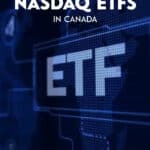The 7 Best NASDAQ ETFs in Canada for 2023

There’s never a dull moment when you’re investing in the ever-evolving tech sector. But with so much volatility, trying to pick individual tech stocks is a fool’s game. For those looking to diversify their portfolios and capitalize on the growth potential of technology giants, a NASDAQ-100 ETF offers a smarter way to invest.
As a Canadian investor, you have a variety of options to choose from when it comes to NASDAQ-100 ETFs. Each fund tracks this renowned index differently, offering potential benefits and trade-offs for different investment strategies.
In this article, we explore the best NASDAQ-100 ETFs available in the Canadian market and provide insight on adding them to your portfolio.
What Are NASDAQ-100 ETFs?
NASDAQ-100 ETFs are exchange-traded funds that track the performance of the NASDAQ-100 Benchmark Index. The index comprises the 100 largest non-financial companies listed on the NASDAQ stock market, with the companies coming from various industries, such as technology, healthcare, and consumer services. Some of the biggest names on the NASDAQ include Apple, Amazon, Microsoft, and Tesla.
Investing in the NASDAQ-100 index exposes you to the performance of these often innovative and growth-oriented companies. And by purchasing an ETF, you’re buying a basket of stocks representing the underlying index.
It’s a cost-effective way to diversify your investment portfolio since you’re not buying individual stocks. Instead, you’re gaining broad exposure to the entire index through a single investment.
Before you invest in a NASDAQ-100 ETF, consider your financial goals, risk tolerance, time horizon, and investment strategy. This will help you determine if a NASDAQ-100 ETF is the right fit for your portfolio.
Top Canadian NASDAQ-100 ETFs
In this section, you will find a list of some of the best NASDAQ-100 ETFs available in Canada. These ETFs are designed to track the performance of the NASDAQ-100 Index, providing you with exposure to some of the largest and most successful companies in the technology sector.
1. BMO NASDAQ 100 Equity Hedged to CAD Index ETF (ZQQ)
ZQQ offers a cost-effective way to track the performance of the NASDAQ-100 Index while reducing currency risk by hedging the US dollar exposure back to Canadian dollars. This ETF has approximately $1.5 billion in assets and a management expense ratio (MER) of 0.39%.
- Currency exposure: CAD-Hedged
- Management Expense Ratio (MER): 0.39%
- Assets Under Management (AUM): $1.5 billion
- Sector Breakdown (Top 3): Technology (49.6%), Comm Service (16.9%), Cons. Cyclical (14.5%)
2. iShares NASDAQ 100 Index ETF (CAD-Hedged) (XQQ)
XQQ aims to replicate the NASDAQ-100 Index’s performance while hedging any currency risk in Canadian dollars. It’s one of the most popular Canadian NASDAQ ETFs, with over $2 billion in assets under management.
- Currency exposure: CAD-Hedged
- Management Expense Ratio (MER): 0.39%
- Assets Under Management (AUM): $2.1 billion
- Sector Breakdown (Top 3): Technology (51.3%), Comm Service (17.1%), Cons. Cyclical (14.5%)
3. Invesco NASDAQ 100 Index ETF – CAD Hedged (QQC.F)
QQC.F provides exposure to the 100 largest non-financial companies listed on the NASDAQ-100 Index while managing the currency risk from converting USD to CAD.
- Currency exposure: CAD-Hedged
- Management Expense Ratio (MER): 0.20%
- Assets Under Management (AUM): $621 million
- Sector Breakdown (Top 3): Technology (51.3%), Comm Service (17.1%), Cons. Cyclical (14.5%)
4. Horizons NASDAQ-100 Index ETF (HXQ)
HXQ is a fantastic way to gain exposure to the top 100 non-financial publicly-traded companies in the US. The fund’s base currency is the Canadian dollar, and it does not use currency hedging.
- Currency exposure: Unhedged
- Management Expense Ratio (MER): 0.28%
- Assets Under Management (AUM): $534 million
- Sector Breakdown (Top 3): Technology (51.3%), Comm Service (17.1%), Cons. Cyclical (14.5%)
5. BMO NASDAQ 100 Equity Index ETF (ZNQ)
ZNQ offers broad exposure to the NASDAQ 100 Index, including numerous mega-cap tech companies like Apple, Microsoft, and Amazon.
- Currency exposure: Unhedged
- Management Expense Ratio (MER): 0.39%
- Assets Under Management (AUM): $378 million
- Sector Breakdown (Top 3): Technology (51.1%), Comm Service (17%), Cons. Cyclical (14.4%)
6. Invesco NASDAQ 100 Index ETF – CAD (QQC)
QQC allows Canadian investors to access the same NASDAQ 100 fund that Invesco offers in the US, QQQ, but with the added benefit of being CAD-based. It is a relatively small fund in terms of Assets Under Management.
- Currency exposure: Unhedged
- Management Expense Ratio (MER): 0.20%
- Assets Under Management (AUM): $105 million
- Sector Breakdown (Top 3): Technology (51.3%), Comm Service (17.1%), Cons. Cyclical (14.5%)
7. Horizons NASDAQ-100 Covered Call ETF (QQCC)
QQCC is designed to expose investors to the NASDAQ-100 Index while generating additional income through a covered call strategy.
- Currency exposure: Unhedged
- Management Expense Ratio (MER): 0.90%
- Assets Under Management (AUM): $126 million
- Sector Breakdown (Top 3): Technology (50.8%), Comm Service (17.0%), Cons. Cyclical (14.3%)
When choosing a NASDAQ-100 ETF, consider currency exposure, management fees, and past performance.
How To Buy NASDAQ-100 ETFs In Canada
The best way to purchase a NASDAQ-100 ETF in Canada is via an online broker. And while there are more than a dozen online brokers in Canada to choose from, some are better than others when purchasing Canadian ETFs.
Here at MapleMoney, we recommend Questrade for ETF purchases. Questrade is one of Canada’s largest independent discount brokerages and doesn’t charge a commission fee for ETF purchases. There is a small fee when you sell.
But with other brokers charging as much as $9.99 on ETF trades, you’ll save money with Questrade. In addition to no-fee ETFs, Questrade doesn’t charge annual fees for their accounts, and their stock trades, which start as low as $4.95, are among the lowest in Canada.
Wealthsimple Trade is another online broker offering free ETF trades, but their trading platform, including their market research tools, isn’t as robust as Questrade’s. Still, they are an excellent option for beginners.
To learn more about Questrade, check out our full review, or click here to open a Questrade account and get started.
Pros and Cons of Investing in NASDAQ-100 ETFs
NASDAQ-100 ETFs are an excellent way to gain exposure to some of the US market’s largest and most innovative companies. But the sector is not without its risks. Here’s a list of pros and cons to consider before buying a NASDAQ-100 ETF
Pros
- Diversification: NASDAQ-100 ETFs provide a diversified portfolio of the top 100 large-cap companies listed on the Nasdaq. Investing in an ETF broadens your investment exposure and reduces the overall risk associated with individual stock holdings.
- Low Cost: ETFs have lower fees than actively managed mutual funds, making them an affordable option for investors looking to invest in the Nasdaq 100. iShares XQQ ETF, one of the best Nasdaq ETFs available to Canadians, has a management expense ratio (MER) of just 0.39%.
- Currency Hedging: iShares NASDAQ-100 Index ETF (CAD-Hedged) (XQQ) uses currency hedging* to eliminate currency exchange rate volatility, providing stability in investment returns for Canadian investors who want to invest in US companies without worrying about exchange rate fluctuations.
- *Note that currency hedging may or may not be the best strategy, depending on your situation.
Cons
- Volatility: The technology sector, which is included in the Nasdaq 100, can experience high levels of volatility. When investing in these types of ETFs, you need to be prepared for fluctuations in the value of your investment.
- Income Taxes: If you’re a Canadian investor, you may have to pay taxes on the dividends received from your NASDAQ-100 ETF investment. Consult with a tax professional to help you understand the implications of your specific situation.
- Currency Hedged vs. Unhedged: Deciding whether to invest in a currency-hedged ETF, like the iShares XQQ ETF, or an unhedged version can be challenging. Each offers different advantages and disadvantages, depending on your investment preferences and the potential impact of currency fluctuations on your returns.
Overall, investing in a NASDAQ-100 ETF exposes you to a diverse range of companies listed on the Nasdaq exchange. Consider these pros and cons before deciding which ETF works best for your investment objectives and time horizon.
Is There a Best NASDAQ ETF?
While we’re not naming a single best NASDAQ ETF in Canada, consider the fees (MERs), how long the fund has been in existence, the number of assets under management (some funds are much larger than others), and whether the fund is hedged or unhedged, depending on your preference.
The technology sector can be volatile, so assessing an ETF’s risk level before investing is vital. Remember that while past performance doesn’t guarantee future returns, reviewing historical data can give you an idea of each ETF’s consistency relative to the market.
Finally, always review your investment strategy regularly and adjust your portfolio accordingly. This way, you can ensure that your investments align with your financial goals.
NASDAQ FAQs
Can you buy the NASDAQ index in Canada?
You cannot directly buy the NASDAQ index itself, but you can invest in ETFs that track the performance of the NASDAQ index. In Canada, there are several popular NASDAQ ETFs such as iShares Nasdaq 100 ETF (XQQ), BMO Nasdaq 100 Equity Index ETF (ZNQ), and Invesco NASDAQ-100 Index ETF (QQC).
What is the Canadian version of QQQ?
The Canadian version of QQQ (Invesco QQQ Trust) is the Invesco NASDAQ-100 Index ETF (QQC). This ETF is listed on the Toronto Stock Exchange (TSX) and tracks the performance of the NASDAQ-100 index, providing Canadian investors with exposure to the largest US technology and non-financial companies.
Is it a good time to invest in a NASDAQ-100 ETF?
Whether or not you should invest in a NASDAQ-100 ETF depends on several factors, including your investment objectives, risk tolerance, and time horizon. While growth-oriented technology companies listed on the NASDAQ have demonstrated strong returns, the market can be volatile, and there are times when these stocks can and will lose value. That’s why it’s so important to do the proper research, assess your risk tolerance, and seek advice from a financial professional before you make a final decision.

